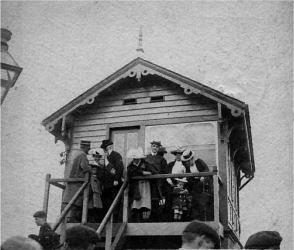
The changing fortunes of Glenavy railway station
By The Digger

A rare picture of Glenavy signal box on the morning of 12th July, 1902
as the Orangemen leave for their demonstration in Hillsborough.
Dr. Mussen is standing in front of the door (with beard).
IT isn't really that surprising that the 14 x 4 inch round ended Great Northern Railway cast iron station nameplate bearing the name `Glenavy' sold for 260 in an auction last year in England. Railway memorabilia is in demand by collectors worldwide.
Travelling by rail to Glenavy as a passenger is now impossible following the closure of the line to the public. I was told recently by a Northern Ireland Railways official that the line was kept open for operational reasons, which included the training of new drivers.
The station at Glenavy is now closed and a sign has been erected where the entrance was once telling the reader all enquiries relating to the station should be directed to NIR.
The Antrim Line opened on November 13 1871, just over ten years since the passing of the Act of Parliament authorising its construction. The Belfast Newsletter of November 14 1871 reports that a display of fireworks took place in Crumlin on the evening of the opening.
I found a record of a station master called Mahood at Glenavy in 1888.The stationmasters at Glenavy, as in Lisburn, were likely to experience accidents, tragedy and incidences of dissatisfied customers.
The local papers reported a serious accident at a crossing on the line a few miles on the Lisburn side of Ballinderry in July 1891. The train and carriages were returning from leaving Orangemen off at Glenavy and struck a cow on a crossing, derailing a cattle wagon attached to the train. The fireman on the train, Thomas Jess, broke one of his legs whilst restoring the wagon to the rails.
On January 28 1905, the Lisburn Herald reported an inquest had been held on the body of Robert Waddel, who had been struck approximately one and a half miles on the Crumlin side of Glenavy by the 8.30am train travelling to Antrim.
On Saturday February 3 1900 the Lisburn Standard reported a civil bill brought by Henry Ballance from Crew, Glenavy against the G.N.R. Henry was the brother of John Ballance who became Prime Minister in New Zealand less than ten years earlier. Mr Ballance alleged he had given the stationmaster instructions for a cattle truck to be provided on December 13 1899 for transporting cattle to a show. Mr Ballance turned up at the station with the cattle which he had to return to Crew again due to the unavailability of the promised truck. The judge gave a decree of £1. The stationmaster at Ballinderry who had received the order from Mr Ballance was named as "Mr. Swarbrig."
In old street directories dating 1897 -1899 David Swarbrig is listed as the clerk and stationmaster at the Telegraph Office at Glenavy Railway Station. He married a local girl called Catherine Wilson, daughter of Robert and Eliza Wilson from Greenhills, Glenavy. Catherine died in 1932 at Skerries, County Dublin. There is a headstone at Templecormac graveyard, outside Ballinderry which marks the grave of Catherine. It is spelt using with the two "g" s. Her mother, grandmother and great grandmother are all listed on the headstone together with other family members.
Incidentally David Swarbrig was the grandfather of Dean Norman Barr, former Rector of Derriaghy parish and the late Canon Osbourne Barr, Booterstown, Dublin.
David was a member of the local Glenavy Orange Lodge L.O.L. number 227.
In 1900 William Sherlock is listed as the stationmaster and on April 14 1906 he was presented with a gold watch and chain by the community of Glenavy as a token of their appreciation of his courtesy and attention to the travellers on the line. In 1898 when he married Dorothea Robinson at Lylehill Presbyterian church.
They had two daughters - Margaret and Ruth and two sons - William David and Arthur Mussen Sherlock. They named one of their sons after Dr. Mussen the local doctor, Coroner for South Antrim and a prominent member of the Orange Order. William Sherlock was also a member of L.O.L. 227 a lodge known locally as "the Doctor's Lodge" after Dr. Mussen.
William died on November 27 1952. He is buried at Crumlin Presbyterian Churchyard.
We learn from the Rev. Charles Watson's history of Glenavy Parish titled 'Glenavy Past and Present' published in 1892, that trains travel each way between Lisburn and Antrim four times daily. In 1902 a published local time table for August 1902 confirms departure times from Antrim to Lisburn as "8.5, 11.50am; 1.30, 6.0 pm. Sundays - 7.0 pm"
In May 1922 the Glenavy to Lisburn timetable read "Weekdays - 8.7, 10.42am; 6.12pm."
The Antrim line was initially owned by the Antrim and Dublin Junction Railway, sold to the Great Northern Railway and then to the Ulster Transport Authority. It closed on November 12 1960 and remained out of use until Northern Ireland Railways reopened it on January 28 1974. The line was closed a number of years ago. The Digger can be contacted at diggerarticle@hotmail.com. Next: The Digger recalls some personal memories of Glenavy station during the Second World War.
Visit the Diggers new web site www.glenavyhistory.com
30/03/2007
